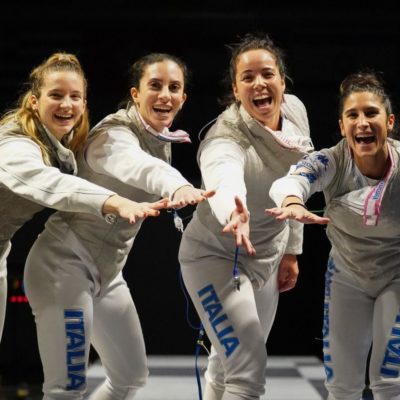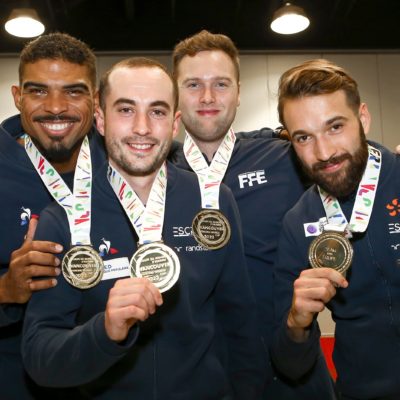TEAM OPERATION Now that I gave the technical specifications of key staff persons on the US fencing team, it might be helpful to give a thumbnail sketch of a day in the life of the team. From early morning to late evening the team leader, Bob Largman, is keeping track of the athletes who are fencing that day and the bus they need to be on for enough time to warm up prior to their competition. There is another group of athletes who will be training at the ACG and he needs to make sure when they will be leaving and returning and that key people at the ACG are notified. Those athletes who are not competing and not practicing, he wants them to know when US fencers will be competing, i.e., their start times and who they are fencing and then make sure they know the bus schedule to the venue. Other fencers have parents in town who are looking for the tickets their athlete has been given by the USOC. Arrangements need to be made for pick up of the tickets. Then there is the official team picture – when will it be taken and how to make sure everyone will be at the appropriate place and time. Now many of you have had the experience of coordinating people to places and with 14 athletes, four staff, and ancillary personnel at the adjacent living quarters in Dekalia and a half hour drive away at the ACG this can be quite challenging. And what might just take 20 minutes from beginning to end can end up being 40 minutes or longer!! Then Bob needs to make sure the athletes are rounded up to get on the bus to the venue for their competition. Once at the venue he needs to make sure they and the coach or coaches have what they need, whether it is start time, location they need to be at or water. And we must not forget that the armorer needs to be with the team, especially at this point in case any of the equipment goes awry. The armorer needs the blown up version of the Boy Scout motto of “Be Prepared”, be it tools, parts, screws, springs, wire, solder, etc. You name it, he needs it with him. Now just imagine trying to get through security every day with all that equipment. But back to Bob who now has the athletes at the venue and must now deal with the phone calls, many of which are the parents looking for their tickets, verifying start times, looking for more tickets, wanting to arrange to meet their athlete, etc. And, of course, there are the administrative details with the USOC, little things, but time consuming – team leaders meetings, paper work whenever someone has lost a valuable or has had a valuable disappear and more myriad details that a beaucratic organization always needs to keep track of all the people under their umbrella of responsibilities. With 14 adult athletes anything is bound to happen. As for the captain of the team, Jeff Bukantz, he needs to make sure that the competition is being conducted fairly, mainly in terms of the pool of referees being used for that round, that the athletes and/or coaches have no complaints about the tournament and that the coaches are where they want to be during the bout. He gathers the information generated each day by the international fencing federation, the FIE, and checks to make sure there aren’t any changes. He is at the ready during each bout in case some problem arises. Outside of the competition he works with the coaches on their needs for practice and coordinates with Bob on training details. He is always available to the athletes and coaches who may need to discuss the competition or the strategy or just normal interpersonal relationships. So much of these jobs entail being at the ready for any situation that may arise and finding an appropriate solution as soon as possible. It is also being aware of the sensitivities of the athletes including their superstitions to allow the athlete to reach the point that allows him or her to perform at the very best. For that one needs personnel who are attuned to athletes and how they function and to be able to tolerate their idiosyncrasies. DAY 2 OF THE COMPETITION This was Kamara James’ day – the individual women’s epee. She had to fence the Russian, Lougounova. It was an evenly matched bout and Kamara fenced well against her opponent who had an extremely long lunge and accurate point, hitting arm, wrist, leg into the preparation. Kamara kept the score close and on another day could have beaten her. This was not the day and it was a big disappointment to Kamara and her coach Kornel Udvarhelyi. All in all though Kamara has a great future and can only become one of the best woman epee fencers. In women’s epee, she is young and so will only improve with age – the average age of the women’s epee group must be in the 30’s. DAY 3 Today was men’s foil day and the stars were certainly misaligned. It was a difficult day for each of the three fencers, with Jed Dupree succumbing in the round of 64, Jon Tiomkin, coming back to win his first bout, only to lose to one of the best fencers in the world, Cassares of Italy, in the round of 32 and Dan Kellner, winning his first bout soundly in the 32, and losing a close one in the 16. Dan is certainly one of our best foil fencers as well as one of the smartest but today it was not quite in synch and the bout was lost 15-14, a true heartbreaker. We all feel for the fencers and the coach, all of whom have worked so hard for this brief moment in time. All those fine lines of life wait for perfect alignment and the secret key that places them just so is so illusive. Each one has learned something today, from within and for themselves. May it help them come together in total unity in just a few days for the team competition.
Share:





